
|
 |
 |
Parkinson full range | Gas Lanterns
Maxill is an abbreviation of Maximum Illumination. The Maxill Lamp was designed for main road lighting whilst the Maxilla range of
lamps was designed to meet the requirements of the Final Report for Group "B" Lighting (1937) with
up to 6 mantles.

|
|
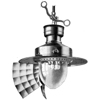
|
Stechford
This is the Parkinson version of the "shadowless" "Rochester" style of
pendant gas-lamp. Could be fitted with Staybrite Steel Back Reflectors for market-place
and flood-lighting, or with the new (1936) "butterfly wing" reflector for road lighting.
Holophane refractors can also be added.
|
|
???
|
??? candle power
|
??? burners
|
???
|
1936 Advert
1936 Paper
1936 Journal
1937 Advert
1938 Journal
1938 Paper
|
|

|
|
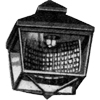
|
Maxill Dual Purpose Gas Lamp / Maxill Standard
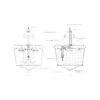
Believed introduced in 1936 and in two designs. The double reflector was developed
after experiments in Bournemout Road, Poole. It quickly became popular for the lighting of arterial
roads and new housing estates in the same year. It consists essentially of twin-burners at the foot of paraboloid facetted Staybrite Steel reflectors,
which are positioned back-to-back. It was designed to meet the requirements of the
MOT's Interim Report, for 18' mounting height, and
for central or staggered lighting schemes. Supplied with an even number of mantles from 4 to 12.
It embodies a twin burner of unique patented construction, such that the gas enters an
annulus surrounding the mixing chamber, passes vertically downwards to the nipple, and
thence upwards, drawing in air from the body of the lamp, the gas and air regulation being
effected through the hinged door at the base of the lamp. Each burner is at the focus of a
faceted Staybrite steel reflector of paraboloid form. Candle powers of 2000 for the
six-light lamp and 3000 for the twelve-light lamp are obtained.
The reflectors are of the dispersive type and are designed to secure evenness of illumination over the carrigeway,
rather than a high concentration of candle power in one direction. The patented burner possesses certain interesting
features. The gas passes downwards through an annulus to the nipple, and thence upwards into the mixing chamber, drawing
in air from the body of the lamp. This ensures efficient combustion and also obviates the necessity for an elaborate
ventilating device to prevent the possibility of contamination of the primary air by products of combustion. Moreover, with
a bottom door, regulation of the gas and air, replacement of the mantles and cleaning, can all be effected from
the base, very important maintenance considerations.
With staggered spacings of 150 feet and for roads of normal width, Class F and E
illumination is obtained with the six-light and twelve-light lamps respectively. Mounting
heights of 18 to 25 feet for the six-light and 21 to 25 feet for the twelve-light lamp
are recommended. The lantern is ususally advertised as achieving a Class F illumination with
staggered spacing of 150 feet and a mounting height of 18 to 25 feet.
The reflectors may be set to any reasonable predetermined vertical and azimuthal angle,
and are generally adjusted to throw the maximum beam at an azimuthal angle of 10° into
the road for staggered systems, and 0° azimuth for central suspension.
The burners and reflectors are housed in a lantern of square cross section, slightly tapering towards the base,
and fitted with pyramidal roof and base. From two to sixteen mantles can be housed in the same lantern, a valuable asset
when conversions to higher power units are required by increase in traffic and greater necessity for a higher
degree of illumination.
Has a maximum candle power of 2000 with a total gas consumption of 15 cubic feet per hour.
The two 56-facet Paraboloid Metal Adjustable Refectors are of the dispersive type. The case is of modern design, square
in plan, and tapered from the waist downwards. Gas and air regulator is housed in the body of the lamp and
free from contamination of the primary air by products of combustion. Provides a good Class F Illumination for roads of
normal width. Often shown advertised on Adastra Sectional Steel Columns. Later described as
a Group "A" lantern. Is extensively installed, and is ideal for competitive schemes being highly efficient,
soundly constructed and low priced.
Redesigned in 1945, it's intended for use in Group A roads at a mounting height of 25'. It houses 6-12 mantles and
can be arranged for both suspension or upright mounting. Reflectors
can be adjusted horizontally and vertically for even spread of illumination. This adjustability
permits the most effective distribution of light for variations in the
configuration of the road including bends, gradients and varying road widths.
|
|
???
|
3000 candle power
|
2-16 burners
|
Top Entry / Post Top
|
1936 Advert
1936 Journal
1936 Advert
1936 Paper
1936 Journal
1936 Advert
1936 Advert
1937 Advert
1937 Journal
1938 Journal
1938 Advert
1938 Advert
1938 Programme
1938 Paper
1939 Journal
1945 Advert
1945 Programme
1951 Book
|
|
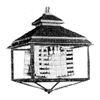
|
Maxill Type "G"
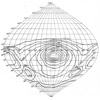
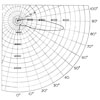 Designed for main and arterial road lighting. First shown at the APLE's
Folkestone Conference in 1937. Fitted with a pair of burners (each comprising
three to six mantles) fitted at the foci of facetted paraboloid reflectors of
anodised aluminium and housed in a square casing of modern design. Each burner is
fitted with a separate gas and air regulator and mixing chamber, located in the body
of the lamp, obviating any possibility of contamination of the
primary air by the products of combustion. The separate gas and air supply to each
burner makes for better aeration and a higher efficiency. An important feature of this
lamp is the adjustability of the reflectors in both vertical and horizontal planes.
Side doors and a bottom door allow for easy cleaning and maintenance. Used for Group "A" Lighting. A most efficient and adaptable unit for street lighting. Square in section, of
pleasing design in keeping with modern trends. Each preheater is provided with separate supply pipe with gas and
air adjustment ensuring adequate aeration and high efficiency. Twin reflectors of facetted anodised aluminium give
very high reflectivity and the greatest possible distribution. The patented reflectors are adjustable in all directions,
provision being made for collect distribution of light on acute road bends, a feature not available in any
other large gas lamp. The reflectors are of anodised aluminium which combines a
high degree or reflectivity with a considerable proportion of diffuse reflection,
thus permitting a satisfactory distribution with a minimum of glare. The independent
adjustability of the reflectors in both planes renders the lamp idea for roads
containing bends and gradients.
Designed for main and arterial road lighting. First shown at the APLE's
Folkestone Conference in 1937. Fitted with a pair of burners (each comprising
three to six mantles) fitted at the foci of facetted paraboloid reflectors of
anodised aluminium and housed in a square casing of modern design. Each burner is
fitted with a separate gas and air regulator and mixing chamber, located in the body
of the lamp, obviating any possibility of contamination of the
primary air by the products of combustion. The separate gas and air supply to each
burner makes for better aeration and a higher efficiency. An important feature of this
lamp is the adjustability of the reflectors in both vertical and horizontal planes.
Side doors and a bottom door allow for easy cleaning and maintenance. Used for Group "A" Lighting. A most efficient and adaptable unit for street lighting. Square in section, of
pleasing design in keeping with modern trends. Each preheater is provided with separate supply pipe with gas and
air adjustment ensuring adequate aeration and high efficiency. Twin reflectors of facetted anodised aluminium give
very high reflectivity and the greatest possible distribution. The patented reflectors are adjustable in all directions,
provision being made for collect distribution of light on acute road bends, a feature not available in any
other large gas lamp. The reflectors are of anodised aluminium which combines a
high degree or reflectivity with a considerable proportion of diffuse reflection,
thus permitting a satisfactory distribution with a minimum of glare. The independent
adjustability of the reflectors in both planes renders the lamp idea for roads
containing bends and gradients.
The lantern is of square design, with pyramid top, and is constructed of non-corrosive materials and
partly glazed with armour plate glass. There are two separate burners, each with its own gas and air
regulator, the mantles being in the form of clusters approximately 10" apart, and varying in number
up to seven on each superheater. Just above the mantles and entirely dividing the lantern is a
white vitreous enamel reflector which carries two re-designed anodized aluminium reflectors, giving an
improved light distribution to those reflectors previous used. These reflectors are independently adjustable
in both horizontal and vertical planes, special fittings being available for providing abnormal
azimuth bias where required for the proper lighting of sharp bends. The whole of the interior
fittings, i.e. burners and reflectors, can be detached from the lantern by undoing five nuts,
thereby making maintenance very simple. This lantern is very suitable for midnight reduction
and other special features, such as half-night uni-directional lighting.
Has a 'Type 1 Distribution' (Non Cut-Off) according
to the draft 1945 specification; and can be adjusted to a 'Type 2 Distribution' (Semi Cut-Off) with adjustment.
|
|
2 x 3-6 burners
|
??? candle power
|
6-12 burners
|
???
|
1937 Advert
1937 Journal
1938 Advert
1938 Journal
1938 Advert
1938 Programme
1938 Advert
1939 Advert
1939 Paper
1943 Advert
1943 Journal
1944 Journal
1944 Advert
1945 Paper
|
|
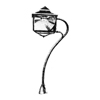
|
Maxilla Brimax Type / Brimax Maxilla
Initially called the Maxilla Brimax Type. Also first called
Brimax Type Maxilla Lamp. First shown at the APLE's
Folkestone Conference in 1937. Intended for the lighting of residential
thoroughfares. It embodies the well-known features of the Maxilla
series with a gas and air regulator in the body of the lamp, and concealed
together with the clock controller, etc. behind the back reflector.
The latter consists of a faceted butterfly wing reflector of anodised
aluminium or chromium brass and is supported by a narrower facetted refelctor at
the front of the lamp. Used for Group "B" Lighting. A lamp of modern and pleasing design with a swan-neck securely fixed to the waist.
It is fitted with two wing reflectors of 16 and 40 facets in paraboloid sections, which correctly distribute the
light along the kerb. Gas and air adjustment, controller and igniter are housed behind the larger wing reflector.
The case is constructed on similar lines to the larger "Maxill" permitting uniformity in lamp design. The
reflectors can be independently adjusted. Also incorporates extended supply tubes as integral parts of the lamps
so that an increase in mounting height is obtained without the use of extension pieces. The high distribution obtained has been
acheived by the employment of scientifically designed refractors.
Adverts in 1938 state that it's available in Upright (Post Top), Suspension and Brimax Types. The Brimax is the version
with the side-entry double-arm bracket.
Redesigned in 1945, the term "Brimax" seems to have been dropped. The lantern is now part of the Maxilla
range, for Group "B" lighting at a mounting height of 13-15 feet. The swan neck is an integral part of the
lantern. Reflectors
can be adjusted vertically for even spread of illumination.
|
|
???
|
??? candle power
|
2-6 burners
|
Post Top
Top Entry
"Brimax"
|
1937 Advert
1937 Journal
1938 Journal
1938 Advert
1938 Advert
1938 Programme
1938 Advert
1939 Programme
1939 Advert
1944 Journal
1945 Programme
1947 Programme
|
|
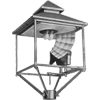
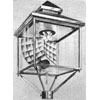
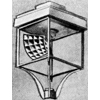
|
maxilla frog type / maxilla upright
Used for Group "B" lighting. Construced similar to the "Brimax." Can be provied with Frogs from 9" to 3'6"
permitting uniformity in mounting height to conform with the Final Report.
Redesigned in 1945, a mounting height of 13-15 feet is suggested for Group "B" roads. Reflectors
can be adjusted vertically for even spread of illumination.
Especially designed for
residential areas and roads for Group 'B' lighting (as per the MOT Final Report). They have a mounting height of
13-15 ft. and are a vast improvement on the pre-war Maxilla lanterns. Standard interchangeable parts have
been adopted where possible which has reduced the cost of manufacture and the number of components required as
spares. The Suspension Lanterns are all fitted with a concealed safety chain device. Fixed Nipples and
constant pressure governors are included as standard fittings. Street lighting effectiveness has been
enhanced by the adjustability of the faceted reflectors, which are constructed of aluminium anodised by an
improved process, permitting effective distribution of light for variations in the configuration of the
road, including bends, gardients and varying road widths. Rectangular sides replace the tapered in order to
facilitate easy replacement of five glass panes (sides and base), each being of equal size. The whole of the
burner assembly, from nipple to pre-heater, is the same for all sizes of pre-heaters from 2 to 6 light.
The standard venturi tubes and fixed nipple are controlled to the size required for the particular size of preheater.
The venturi maintains the 7-1 ratio whatever quantity of gas is passed. The Astragels are made as narrow
as possible, so that, with the frog sprays twisted to present the smallest surface to the path of light, shadows
have been reduced to a minimum. The hoods are stamped in one piece throughout, ensuring resistance to
weather and are constructed of copper. Neatly housed and concealed behind the facetted reflectors of the
Maxilla Lantern are the ignition device, clock controller and constant pressure governors. The reflectors
are supported by a tripod fitted to the venturi and permitting vertical adjustment. The control assembly can
be easily removed with Comet igniter, leaving interior of lantern free for cleaning. The fly-cap tighted
union at the base of the nipple holder permits this easy removal of the controls, faceted reflector and venturi
tube, the latter being "olived" at the top to make a gas-tight push fit connection within the burner supply tube.
The whole reflector unit is an accurate stamping in anodised light
alloy sheet. By ingenious design, each pane of glass is the same size to facilitate replacement and
reduce glass stocks. Has many interchangable parts with
the Maxilla.
The Suspension Lanterns are all fitted with a concealed safety chain device. Fixed nipples and constant pressure
governors are included as standard fittings to ensure the laboratory results are reproduced. Rectangular sides
replace the tapered in order to facilitate easy replacement of five glass panes (side and base), each being
of identical size. Heat-resisting glass panes are introduced into the lantern with the larger size burner
assembly, and are placed opposite the 40-facetted reflector. The whole of the burner assembly, from nipple to
pre-heater, is the same for all lanterns and for all sizes of pre-heaters from 2 to 6-light.
Suitable for all Group B thoroughfares. Upright and suspension lanterns available in sizes 2 lt. to 6 lt. with
40 facetted reflector. Consumption controlled to 2½ cubic feet per burner-hour by constant pressure governor
and fixed nipple.
|
|
???
|
??? candle power
|
2-6 burners
|
Post Top
|
1938 Journal
1938 Advert
1938 Programme
1938 Advert
1943 Advert
1944 Advert
1944 Journal
1945 Advert
1945 Programme
1946 Programme
1946 Paper
1947 Programme
1947 Journal
1947 Advert
1947 Paper
1947 Advert
1951 Book
1951 Book
1953 Advert
|
|
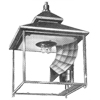
|
maxilla suspension
Used for Group "B" lighting. Construced similar to the "Brimax."
Redesigned in 1945, a mounting height of 13-15 feet is suggested for Group "B" roads. Reflectors
can be adjusted vertically for even spread of illumination.
Especially designed for
residential areas and roads for Group 'B' lighting (as per the MOT Final Report). They have a mounting height of
13-15 ft. and are a vast improvement on the pre-war Maxilla lanterns. Standard interchangeable parts have
been adopted where possible which has reduced the cost of manufacture and the number of components required as
spares. The Suspension Lanterns are all fitted with a concealed safety chain device. Fixed Nipples and
constant pressure governors are included as standard fittings. Street lighting effectiveness has been
enhanced by the adjustability of the faceted reflectors, which are constructed of aluminium anodised by an
improved process, permitting effective distribution of light for variations in the configuration of the
road, including bends, gardients and varying road widths. Rectangular sides replace the tapered in order to
facilitate easy replacement of five glass panes (sides and base), each being of equal size. The whole of the
burner assembly, from nipple to pre-heater, is the same for all sizes of pre-heaters from 2 to 6 light.
The standard venturi tubes and fixed nipple are controlled to the size required for the particular size of preheater.
The venturi maintains the 7-1 ratio whatever quantity of gas is passed. The Astragels are made as narrow
as possible, so that, with the frog sprays twisted to present the smallest surface to the path of light, shadows
have been reduced to a minimum. The hoods are stamped in one piece throughout, ensuring resistance to
weather and are constructed of copper. Neatly housed and concealed behind the facetted reflectors of the
Maxilla Lantern are the ignition device, clock controller and constant pressure governors. The reflectors
are supported by a tripod fitted to the venturi and permitting vertical adjustment. The control assembly can
be easily removed with Comet igniter, leaving interior of lantern free for cleaning. The fly-cap tighted
union at the base of the nipple holder permits this easy removal of the controls, faceted reflector and venturi
tube, the latter being "olived" at the top to make a gas-tight push fit connection within the burner supply tube.
The Suspension Lanterns are all fited with a concealed safety chain device. Fixed nipples and constant pressure
governors are included as standard fittings to ensure the laboratory results are reproduced. Rectangular sides
replace the tapered in order to facilitate easy replacement of five glass panes (side and base), each being
of identical size. Heat-resisting glass panes are introduced into the lantern with the larger size burner
assembly, and are placed opposite the 40-facetted reflector. The whole of the burner assembly, from nipple to
pre-heatr, is the same for all lanterns and for all sizes of pre-heaters from 2 to 6-light.
Suitable for all Group B thoroughfares. Upright and suspension lanterns available in sizes 2 lt. to 6 lt. with
40 facetted reflector. Consumption controlled to 2½ cubic feet per burner-hour by constant pressure governor
and fixed nipple.
|
|
???
|
??? candle power
|
2-6 burners
|
Top Entry
|
1938 Journal
1938 Advert
1938 Programme
1944 Journal
1945 Advert
1946 Advert
1947 Advert
1945 Programme
1946 Programme
1947 Programme
1951 Book
|
|
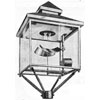
|
maxilla junior
Suitable for side streets and residential areas. Upright lanterns available in 2 lt. and 3 lt. sizes with
"Morelite" reflector. Fitted with Venturi and gas and air adjuster.
|
|
???
|
??? candle power
|
2-3 burners
|
Top Entry
|
1947 Advert
1947 Advert
1951 Book
1953 Advert
|
|
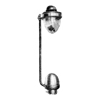
|
Maxlume
Used for Group "B" Lighting. The
reflectors can be independently adjusted. Also incorporates
extended supply tubes as integral parts of the lamps
so that an increase in mounting height is obtained without
the use of extension pieces.
|
|
4 burners
|
??? candle power
|
??? burners
|
Post Top
|
1939 Programme
1939 Advert
|
|
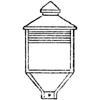
|
Maxillette
Used for "Residential Lighting" and service roads. The mounting height of 11-13 feet isn't recommended
in the Final Report. Only available as Upright unit. The lantern is square in plan
and vertically sided to allow for the incorporation as an integral part of the lantern,
all of the reflectors, clock controllers, governing and ignition devices. The controls
are concealed behind the reflectors.
Rectangular sides replace the tapered in order to
facilitate easy replacement of five glass panes (sides and base), each being of equal size. Has many interchangable parts with
the Maxilla. Uses the 'Mor-lite' adjustable directional reflector.
|
|
???
|
??? candle power
|
1-2 burners
2-4 burners (later)
|
Post Top
|
1945 Advert
1945 Programme
1947 Programme
1947 Journal
|
|
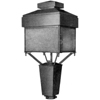
|
|
|
|



